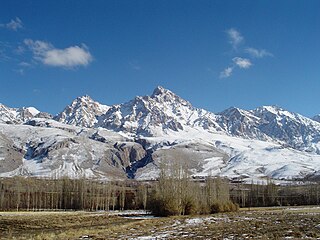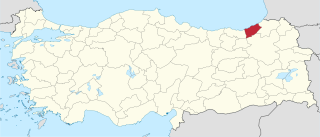Related Research Articles

Anatolia, also known as Asia Minor, is a large peninsula in Western Asia and the westernmost protrusion of the Asian continent. It constitutes the major part of modern-day Turkey. The region is bounded by the Turkish Straits to the northwest, the Black Sea to the north, the Armenian Highlands to the east, the Mediterranean Sea to the south, and the Aegean Sea to the west. The Sea of Marmara forms a connection between the Black and Aegean seas through the Bosporus and Dardanelles straits and separates Anatolia from Thrace on the Balkan peninsula of Southeast Europe.

Turkey is a large, roughly rectangular peninsula that bridges southeastern Europe and Asia. Thrace, the European portion of Turkey comprises 3% of the country and 10% of its population. Thrace is separated from Asia Minor, the Asian portion of Turkey, by the Bosporus, the Sea of Marmara and the Dardanelles.

Cilicia is a geo-cultural region in southern Anatolia (Turkey), extending inland from the northeastern coasts of the Mediterranean Sea. Cilicia has a population ranging over six million, concentrated mostly at the Cilicia plain. The region includes the provinces of Mersin, Adana, Osmaniye, and Hatay.

The Caucasus Mountains is a mountain range at the intersection of Asia and Europe. Stretching between the Black Sea and the Caspian Sea, it is surrounded by the Caucasus region and is home to Mount Elbrus, the highest peak in Europe at 5,642 metres (18,510 ft) above sea level.

The Zagros Mountains are a long mountain range in Iran, northern Iraq and southeastern Turkey. This mountain range has a total length of 1,600 km (990 mi). The Zagros mountain range begins in northwestern Iran and roughly follows Iran's western border, while covering much of southeastern Turkey and northeastern Iraq. From this border region, the range continues to the southeast under also the waters of the Persian Gulf. It spans the whole length of the western and southwestern Iranian plateau, ending at the Strait of Hormuz. The highest point is Mount Dena, at 4,409 metres (14,465 ft).

The Taurus Mountains are a mountain complex in southern Turkey, separating the Mediterranean coastal region from the central Anatolian Plateau. The system extends along a curve from Lake Eğirdir in the west to the upper reaches of the Euphrates and Tigris rivers in the east. It is a part of the Alpide belt in Eurasia.

Rize Province is a province of northeast Turkey, on the eastern Black Sea coast between Trabzon and Artvin. The province of Erzurum is to the south. It was formerly known as Lazistan, the designation of the term of Lazistan was officially banned in 1926, by patriots. The capital is the city of Rize.

Çamlıhemşin is a small town and district of Rize Province in the Black Sea region of Turkey.

The Kaçkar Mountains, formerly known as the Lazistan Mountains or the Mountains of Khaghtik, are a mountain range that rises above the Black Sea coast in northeastern Turkey.

Mount Kaçkar, with an elevation of 3,937 meters, is the highest peak in the Kaçkar Mountains. The mountain may be climbed by the northeast ridge route beginning from the village Yukarı Kavrun.

The Northern Anatolian conifer and deciduous forests is a temperate coniferous forests ecoregion located in northern Anatolia, Turkey.

The geographical regions of Turkey comprise seven regions which were originally defined at the country's First Geography Congress in 1941. These seven regions are subdivided into twenty one sections, which are further split into numerous areas as defined by microclimate and bounded by local geographic formations.

The Black Sea Region is a geographical region of Turkey.

The following outline is provided as an overview of and topical guide to Bulgaria:

The following outline is provided as an overview of and topical guide to Turkey:

As of 2000 about 9300 species of vascular plant were known to grow in Turkey. By comparison, Europe as a whole contains only about 24% more species, despite having thirteen times the area.

Climate changeinTurkey includes changes in the climate of Turkey, their effects and how the country is adapting to those changes. Turkey's annual and maximum temperatures are rising, and 2020 was the third hottest year on record. Turkey will be greatly affected by climate change, and is already experiencing more extreme weather, with droughts and heatwaves being the main hazards. Current greenhouse gas emissions by Turkey are about 1% of the global total, and energy policy includes heavily subsidizing coal in Turkey. The Environment Ministry co-ordinates adaptation to climate change, which has been planned for water resources by river basin, and for agriculture.

Mount Erciyes, also known as Argaeus, is a volcano in Turkey. It is a large stratovolcano surrounded by many monogenetic vents and lava domes, and one maar. The bulk of the volcano is formed by lava flows of andesitic and dacitic composition. At some time in the past, part of the summit collapsed towards the east.

Lake Borabay, also known as Lake Kocabey, is a landslide-dammed lake in Amasya Province, Turkey. The lake and its surroundings were declared a nature park in 2014.
References
- ↑ KURTER, AJUN. "Glaciers of the Middle East and Africa: GLACIERS OF TURKEY" (PDF). U.S. Geological Survey Professional Paper. 1386-G-1.
- ↑ Ministry of Environment and Urbanization (2018), p. 150